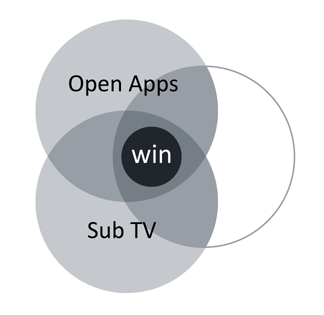The Winning Recipe
There are some key ingredients that will yield success in the living room. The first company to concoct this recipe has the chance to dominate all the other players. Imagine this:
What if the last version of Apple TV had included the App Store, operated by a Apple-developed Wii Remote clone. An Apple Wii, if you will. You would find all the same gameplay that you find on the Wii (and which made it a massive success) at a lower price point with less time investment required, in addition to a flood of new content from the iOS developer ecosystem. You would find great new apps built just for the living room. The iOS home screen of apps and the Wii OS home screen of channels are remarkably similar, aren’t they? It’s not that hard to imagine.
An open platform app store is the first ingredient of the winning recipe.

The second ingredient is a business model for TV and Movies. Remember, people will buy this box for Smart TV, games will be secondary.
Everybody cringes at the thought of yet another set top box in their living room to go along with their Cable/Satelite, DVR, and game console. Nobody wants a box to manage their other boxes, what they want is a simple replacement for all that expensive garbage. The winner’s core function will be as a modest replacement for cable/satellite TV – a destination for cord-cutters comfortable with the likes of Hulu and Netflix.
Flat-fee subscription for all video is the way to deliver content en-masse. Convenience is king in changing customer behavior, and Netflix and the major Cable Networks have shown that subscription is the most convenient way to deliver big content.
If we look far into the future, an “on demand” a-la-carte model could work, but only once the UI for these new boxes becomes second-nature for the users and futuristic Smart TV behaviors become common and standardized. Until then, it’s too much of a hassle for couch surfers. With subscription, you can pay-and-forget, never having to worry about access ever again, so it’s the most attractive core business model here.
Adding that ingredient in, here’s the recipe so far:

Note that Netflix will take care of the subscription video option admirably for pretty much everybody. It’s on every box right now, the question is whether the value of Netflix can continue to grow in the face of a souring reputation among content owners. Don’t forget that Cable/Satellite is in this fight, and they offer a better deal to the content owners right now. There is no way that the content holders will allow Netflix to become a monopoly channel and sink the value of content deals.
The uncertainty over Netflix is not the only thing that makes the TV ingredient matter. Consumers will care about it more than apps, initially. Every box-maker will want better quality content offering than the next guy. Integrated live TV would be a great competitive advantage, for example.
So, how do the competitors stack up against the recipe?
Google is arguably first into the ring with this new generation of boxes. GoogleTV is already out, and it is doing. . . not so great.
Google has problems with TV networks, most of whom are blocking it from accessing their free web episodes. Free access to that content could have been a big incentive for customers to switch to GoogleTV, but it is not in the best interest of the TV networks.
GoogleTV also features a overly complex controller design that isn’t even consistent across the platform at launch.

Even if it had the free content, the user experience would remain inconsistent and cumbersome. GoogleTV illuminates the colossal design problem in allowing a user to simultaneously control Live TV, a DVR, web browser, game, or Facebook app, from their couch (with one hand).

Yikes. The complexity of content available in the living room is one big design clusterfuck of a problem. Google’s attempt to answer that problem was search. Good idea, but search requires a keyboard and nobody wants to type on the couch, they want to surf (Google has reportedly gone back to the drawing board with their UX). The design clusterfuck cannot be solved with a standard TV remote or a wireless keyboard.
Here’s the key element that nobody seems to be paying attention to, the secret ingredient:
The winner will have a single, standard, incredibly awesome controller.
Remember my drawing at the beginning of the article with the ships converging on the TV? The winner will be the company that pulls the motion-sensing Excalibur from the stone. This unclaimed controller-based-UX is what unlocks the potential of Smart TV.
The final winning recipe:

That’s UX with a great couch controller.
There’s a reason why so much high technology is being invested into things like the Wii Remote, Kinect, and Playstation Move. It really matters. Everyone acknowledges that UX is key, but it’s the control method that enables the UX.
How does GoogleTV even relate to gaming? Once you have the couch controller and the associated UX that solves the design problems of these boxes, it will undoubtedly be great for playing games as well. Remember what happened with iOS and Facebook? Neither multitouch screens nor accessible social networks were designed for gaming. They were simply excellent enablers.
To win, Google needs to direct a hardware partner to build them the magic controller. They will need to enforce a standard control design. That’s not a very Googly way of positioning their service – they like to be open, they don’t like to design hardware – but it’s a requirement for good UX in this case.
Google is first into the ring and first to get graded:
